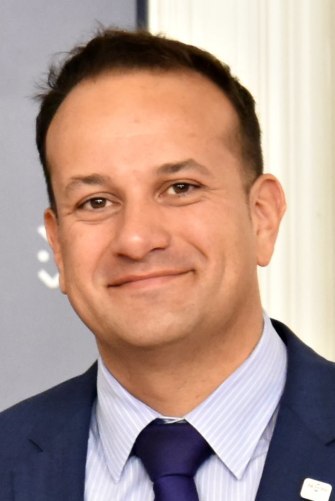
Image open sources from wikipedia
Taoiseach Leo Vradkhar is notable for his Indian background, but how many other Irish politicians have an ethnic minority background?
Dr. Stephan Köppe
All started with a short Twitter post, where I just wondered how the increasing ethnic diversity of Ireland is reflected in the composition of the current Dáil. Somehow this was picked up by several extreme right and left (some identified as Sinn Féin supporters) users who expressed latent xenophobic and anti-Semitic views. I was shocked about the abusive language that was used and how some users suggested to deport me. At the same time, the Irish main stream media ignored the issue when reporting on the new composition of the Dáil. Therefore, it is a timely question how an increasingly ethnic diverse Ireland is represented in the political process. Since this is a complex topic and Twitter might not be the right forum to ask complicated questions, this blog aims to unpack this question step by step.
My starting point is that during the election campaign was a huge attention on gender equality and whether gender quotas would help to increase the share of women TDs. And Ireland fares relatively poor on this indicator in comparative perspective. After this election the share of women in the Dáil increased slightly from 20% to mere 22.5%, lower than the share of women in the parliaments of Iraq or Afghanistan, countries which are often associated with low gender equality and a poor record of women’s rights. So if we think an equal representation of women in parliament is a good thing, shouldn’t also ethnic minorities be represented by their share in society? We can ask that question also with regards to religion, disability or social class, but I will focus on ethnic diversity here.
Before we turn out attention to Ireland, let’s have a look to our closest neighbour. In the recent UK general election 65 MPs with an ethnic minority background were elected or about 10% of MPs. In the 2011 UK census almost 20% identified as ethnic minorities (including those that identified as Irish), which means ethnic minorities are underrepresented by about 50% of their actual population share. Quite similar to the under representation of women in the Dáil.
Ethnic representation in Ireland
What is the situation in Ireland? According to the 2016 census about 4.7 million people live in the Republic. Out of these inhabitants about 4 million hold Irish citizenship. While in most countries citizenship equals voting rights for adults, it is slightly more complicated due to the Anglo-Irish relationship. UK citizens living in Ireland have full voting rights, to the same extent as Irish citizens living in the UK can vote in general elections. In other words, the franchise in Ireland extends to all Irish and British citizens living in Ireland, but excludes non-resident Irish citizens as well as residents with another nationality.
When we use the same indicator as for the UK to estimate ethnic diversity, the Irish figure is about the same. Out of all residents 82 percent identify as White Irish, which is the technical term the Central Statistics Office uses to describe Irish ethnicity. The remaining 18% include Irish Travellers, other White backgrounds, Black, Asian or have not stated their ethnic identity.
Considering that ethnic minorities are underrepresented in Westminster by about half of their share in the population, it is shockingly low for Ireland. Leo Varadkhar is the only representative of an ethnic minority in the Daíl, which equals 0.6 percent. Despite constitution almost 20% of the population, ethnic minorities are only represented by less than 1% of TDs.
This is of course a very inclusive concept of political participation if we measure ethnic identity across the entire population. A more accurate indicator would be to measure the ethnic diversity among the electorate, i.e. Irish and British citizens living in the republic.
About a quarter of a million Irish citizens do not identify as White Irish. These are more than 6% of all Irish citizens. Where are these 10 TDs? Where are the Irish-Black, Irish-Asian, Irish-Polish or Irish-mixed TDs?
Moreover, there are about 100,000 Irish citizens who hold dual citizenship. They make up about 2.3% of those holding Irish citizenship. Most of these are children born in Ireland in the last two decades and are not yet eligible to vote. Who represents these children in the Daíl? Based on these estimates, we would expect about 4 TDs holding dual citizenship.
Why is ethnic representation relevant?
Shouldn’t we hear their voices in the Daíl? Wouldn’t it make Ireland a culturally richer country to hear their stories in parliament. Wouldn’t we want to hear their solutions to the pressing issues that concern all? They might have different experiences and perspectives that would bring a fresh view on Irish policy making. If we aspire to have equal representation of women in parliament, then we should also embrace the same for ethnic minorities. This issue is particular relevant for input and output legitimacy of the Irish political system.
First, ethnic minority representation concerns input legitimacy. The idea is that only an equal representation of all members in the constituency would reflect the will of the people.
Second, output legitimacy concerns that the political system produces effective policy solutions for their constituents. The overwhelming evidence shows that more diverse teams find better solutions and are achieving overall better outcomes for society.
Finally, for a unified Ireland ethnic minority rights will come also to the forefront of the debate beyond the recent immigrant minorities. Should there be quotas for the Traveller and British communities in the Seanad Éireann? With the First Past the Post (FPP) or the Single Transferable Vote (STV) British minority representation will be less of a concern as long as the Irish-British minority is clustered in certain constituencies. The benefit of FPP/SVT is that regional clusters of minorities will always gain sufficient votes for a seat in their constituencies. This would only change if there is more internal migration between Protestant constituencies and the rest of Ireland.
What are the barriers?
In my point of view there are three barriers that limit a more ethnic diverse Dáil: time, electoral system and naturalisation fees.
Regarding time, we have to acknowledge that the Republic of Ireland only experienced any significant immigration after the turn of the century. Many second generation children are going to turn 18 in the next decade. The last local elections have already shown a much more diverse representation at the council level, which will eventually also result in more diverse TDs in the next two decades.
As pointed out above, STV benefits minorities that a clustered regionally, but not if they are spread equally across the country. Hence, ethnic minority candidates have a higher likelihood in ethnically diverse constituencies, such as Dublin or Cork. Yet, it seems most candidates with a minority background ran in rural constituencies. Also a pro-immigrant party, such as Denk in the Netherlands, would struggle to enter parliament in a proportional representation system. Although Denk won three seats in the Dutch parliament, it only achieved 2.1% of the vote share, which would have excluded them in electoral systems that operate minimum thresholds (often above 3% or higher).
Finally, Ireland has one of highest naturalisation fees in Europe at €1125 (2014) similar to three other countries (Austria, United Kingdom and the Netherlands), while 5 out of 9 EU countries charge significantly below €400. Whereas non-EU migrants gain much more than voting rights with naturalisation (residency and work permit), for EU migrants the actual benefit would be limited to voting. Would a family of four spend almost €5000 to gain voting rights? In most cases probably not. There would be two options to extend the franchise for EU migrants: Either reduce the naturalisation fees significantly for EU citizens, closer to the EU median of €400; or give EU citizens similar voting rights as British citizens. There could be a longer waiting period, compared to British citizens (e.g. 5 years), but the existing legislation could be used to acknowledge the new migration patterns.

Dr. Stephan Köppe is a Political Scientist at UCD School of Social Policy, Social Work and Social Justice
